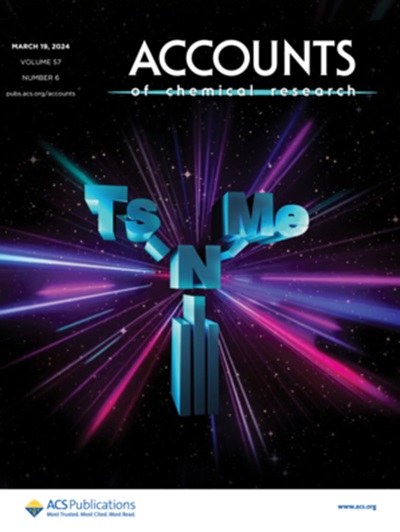碳纳米线设计与合成的合理途径
IF 16.4
1区 化学
Q1 CHEMISTRY, MULTIDISCIPLINARY
引用次数: 0
摘要
碳基材料──通常具有最高级的电子、机械、化学和热性能──通常按尺寸和杂化程度进行分类。这些类别中的大多数是在高温条件下生产的,这种条件提供了平衡决定的结构,但限制了它们的多样性。相比之下,一种新兴的一维(1D)碳材料,即纳米线,可以通过动力学控制的多不饱和小分子的固态反应获得。在分子有机合成中,对反应性进行动力学控制是获得致密碳网络的一种革命性方法。由于其内部的类金刚石核心,这些材料被计算为跨越广泛的机械和光学性质,引入官能团和/或杂原子导致可定制的带隙,并有可能获得传统聚合物或纳米材料所没有的电子状态。获得这些特性需要精确控制固态分子反应途径、化学连通性和杂原子/官能团密度的能力。碳纳米线通常是通过压力诱导的芳香族分子(如苯、吡啶和噻吩)在压缩到23-40 GPa时聚合而成的。虽然获得这些结晶材料所需的高压常常阻碍了合成可行数量的产品,但使用较少的芳香族反应物,以及光和/或热,可以实现更温和的反应压力。迄今为止,从不同的反应物中形成纳米线的成功表明,物理有机原理控制了反应,以及拓扑化学关系,使碳化学的一个新领域出现,该领域将有机化学的控制与只有在长周期固体中才可能实现的物理性质范围相结合。本文章由计算机程序翻译,如有差异,请以英文原文为准。

Rational Approaches toward the Design and Synthesis of Carbon Nanothreads
Carbon-based materials─often with superlative electronic, mechanical, chemical, and thermal properties─are often categorized by dimensionality and hybridization. Most of these categories are produced in high-temperature conditions that afford equilibrium-dictated structures, but limit their diversity. In contrast, an emerging class of one-dimensional (1D) carbon materials, coined nanothreads, are accessible through kinetically controlled solid-state reactions of small multiply unsaturated molecules. While abundant in molecular organic synthesis, exerting kinetic control over reactivity is a revolutionary approach to access dense carbon networks. Owing to their internal diamond-like core, these materials are calculated to span a wide range of mechanical and optical properties, with the introduction of functional groups and/or heteroatoms leading to tailorable band gaps and the potential to access electronic states that are not featured in traditional polymers or nanomaterials. Accessing these properties requires the ability to precisely control solid-state molecular reaction pathways, chemical connectivity, and heteroatom/functional group density. Carbon nanothreads are often synthesized through the pressure-induced polymerization of aromatic molecules (e.g., benzene, pyridine, and thiophene) upon compression to 23–40 GPa. While the high pressures required to achieve these crystalline materials often preclude making synthetically viable quantities of product, the use of lessened aromatic reactants, along with light and/or heat, enables more mild reaction pressures. Success to date in forming nanothreads from diverse reactants suggests that physical organic principles govern the reaction, along with topochemical relationships, enabling the emergence of a new field of carbon chemistry that combines the control of organic chemistry with the range of physical properties only possible in extended periodic solids.
求助全文
通过发布文献求助,成功后即可免费获取论文全文。
去求助
来源期刊

Accounts of Chemical Research
化学-化学综合
CiteScore
31.40
自引率
1.10%
发文量
312
审稿时长
2 months
期刊介绍:
Accounts of Chemical Research presents short, concise and critical articles offering easy-to-read overviews of basic research and applications in all areas of chemistry and biochemistry. These short reviews focus on research from the author’s own laboratory and are designed to teach the reader about a research project. In addition, Accounts of Chemical Research publishes commentaries that give an informed opinion on a current research problem. Special Issues online are devoted to a single topic of unusual activity and significance.
Accounts of Chemical Research replaces the traditional article abstract with an article "Conspectus." These entries synopsize the research affording the reader a closer look at the content and significance of an article. Through this provision of a more detailed description of the article contents, the Conspectus enhances the article's discoverability by search engines and the exposure for the research.
 求助内容:
求助内容: 应助结果提醒方式:
应助结果提醒方式:


